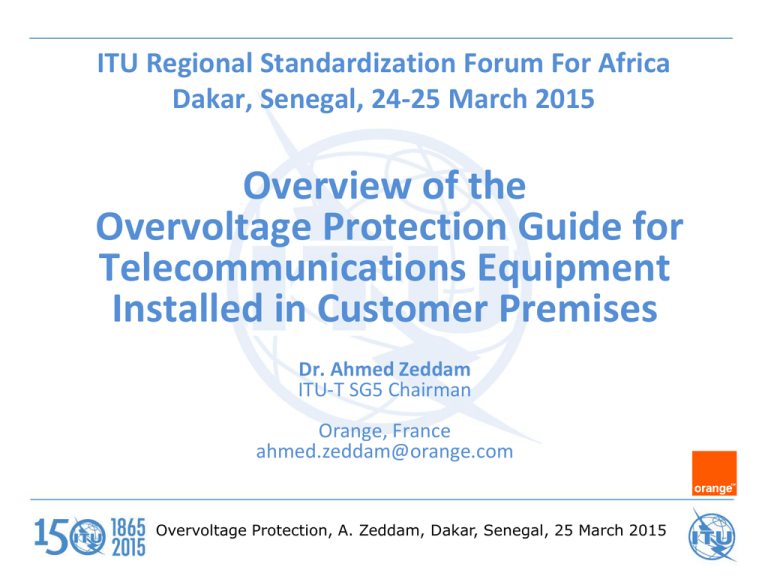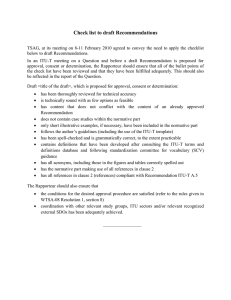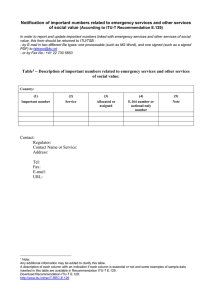Overview of the Overvoltage Protection Guide for Telecommunications Equipment Installed in Customer Premises
advertisement

ITU Regional Standardization Forum For Africa Dakar, Senegal, 24-25 March 2015 Overview of the Overvoltage Protection Guide for Telecommunications Equipment Installed in Customer Premises Dr. Ahmed Zeddam ITU-T SG5 Chairman Orange, France ahmed.zeddam@orange.com Overvoltage Protection, A. Zeddam, Dakar, Senegal, 25 March 2015 Introduction This presentation contains a brief overview of the Overvoltage Protection Guide for telecommunications equipment installed in a customer premise which has been published as international standard [Recommendation ITU-T K.98] 2 Information provided in the guide This Guide contains the information needed to protect telecommunications equipment installed in customer premises from damage due to lightning strikes to the power and telecommunications lines/cables. It considers the impact of the different types of power distribution systems, the length of the telecommunication SPD bonding conductor length and the resistance to earth at the customers’ premise. 3 About protection of Equipment Protecting telecommunications equipment, within a structure, requires a combination of 2 main components: 1. Equipment resistibility. All equipment installed in customer premises has to be compliant with the appropriate resistibility level of Recommendation ITU-T K.21 “ Resistibility of telecommunication equipment installed in customer premises to overvoltages and overcurrents” 2. Additional protective measures : Cable routing practices complying with Recommendation ITU-T K.66 “Protection of customer premises from overvoltages”, Earthing and bonding practices complying with Recommendation ITU-T K.66, Installation of Surge Protective Devices (SPD) for overvoltages protection according to Recommendation ITU-T K.66. This includes the use of both Multi-Service Surge Protective Devices (MSPDs) and primary protectors and finally, Installation of an external lightning protection system (LPS) in order to achieve direct strike protection of the building. 4 Contents The contents of this guide include: Surge coupling and mechanisms of damage Elements of protection Installation of Protection Mains power distribution system types Information is given in this Recommendation with a reference to other documents when necessary 5 Surge coupling and mechanisms of damage This information follows the method of IEC 62305-2 where 4 coupling mechanisms S1 to S4 are defined: S1 S2 S3 S4 = = = = Lightning Lightning Lightning Lightning strike strike strike strike to the building near the building to power line or telecom line near a telecom line This guide concentrates on source S3 6 Elements of protection Equipment resistibility. The test requirements are given in Recommendation ITU-T K.21. This guide has information on selecting the relevant resistibility level e.g. basic, enhanced or special. Enhanced requirements are recommended for mains power equipment. Special requirements are generally used when high isolation levels are required. 7 Elements of protection Correct classification and use of ports. Detail on this is given in Recommendation ITU-T K.75 “Classification of interface for application of standards on resistibility and safety of telecommunication equipment”. For safety and reliability reasons it is important to connect internal cables (do not leave the building) to internal ports and external cables (cables which terminate in the network or run between buildings) to external ports 8 Elements of protection Cable routing Information details are contained in Recommendation ITU-T K.66. The user is referred to Recommendation ITU-T K.85 “Requirements for the mitigation of lightning effects on home networks installed in customer premises” and IEC 60364-4-44 for detailed information. The critical loop is the loop formed by the cabling between the equipments and the earth wires back to the MET. 9 Elements of protection Earthing and bonding Information details are contained in Recommendation ITU-T K.66. Logically the shorter the SPD bond wire the better. This is confirmed in ITU-T K.98 and it is also expected that the lower the resistance to earth at the customers’ premises the better. This is not always so according to Recommendation ITU-T K.98 10 Elements of protection Surge Protective Devices (SPDs). Gives the location of primary protection. Clusters are protected by an Multiservice Surge Protective Device (MSPD) . Primary protection is installed to protect MSPDs when required against direct strikes. It is essential with clamping SPDs that the primary SPD protects downstream SPDs. MSPDs are good insurance against damage. Primary protection is only installed when necessary. 11 Elements of protection Direct strike protection of a structure. Direct strike protection of the structure is outside the scope of Recommendation ITU-T K.98 and the reader is directed to IEC 62305-3. Direct strike protection is only installed when necessary 12 Elements of protection Installation of protection. The installation of SPDs is well covered in Recommendation ITU-T K.66 and the reader is directed to this recommendation. A particular problem can occur when the Neutral is not connected to the PE under surge conditions and solutions are given. The reader is referred to Recommendation ITU-T K.85 for examples and the techniques of risk assessments. 13 Mains distribution systems The mains distribution systems can be described as follows: TN-S. The Neutral and PE is earthed only at the distribution transformer TN-C. The PE and Neutral conductors are linked and earthed at the customer premises TT and IT. The PE and Neutral conductors are not linked. The PE conductor is earthed at, but does not leave, the customer premises 14 Simulations The major part of this guide is the simulation of lightning strikes to power and telecommunication lines/cables. They were performed for: The three types of power distribution systems Earthed equipment and floating equipment Protected and un protected equipment installations 15 Simulations For different earthing and bonding conditions at the customer premises: 100 Ω, 2 Ω and no path to earth 10 metre and 1.5 m SPD bonding conductor length To provide information on the current waveform and the energy dissipation in downstream SPDs (in the equipment or in the MSPD) to enable the rating of these SPDs to be more accurately determined 16 Example of simulated configuration 3.0 kV isolation L SELV PEN Associated earthed equipment N 1.5 kV isolation Switching Centre TNV3 PE MET Earth electrode resistance Earth electrode resistance 17 Example of result of simulation 18 Main results of simulation It is possible to protect telecommunications equipment against a direct strike to the services providing the strike point is more than a couple of hundred metres from the customers’ premise in an urban area or denser area. 19 Main results of simulation Floating equipment is far easier to protect than earthed equipment. Earthed equipment can only be protected when the primary protector bond wire is 1.5 m or less. 20 Conclusions It recommends the use of Multiservice Surge Protective Devices (MSPDs) as the first level of protection Primary protection is only installed to protect the MSPD when necessary The majority of installations could be protected for some tens of Euros per equipment cluster and consequently the reliability of service significantly increased 21 ITU-T/SG5 “Environment & Climate Change” itu.int/go/tsg5 ITU-T/SG5 Series K Recommendations (free of charge) itu.int/ITU-T/recommendations/index_sg.aspx?sg=5 Thank you


